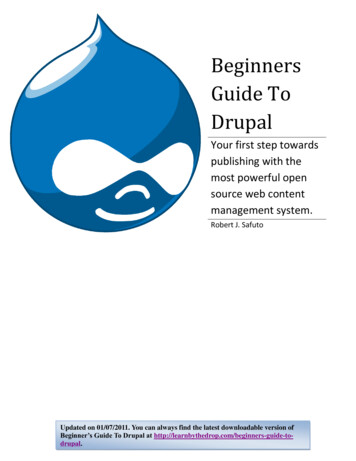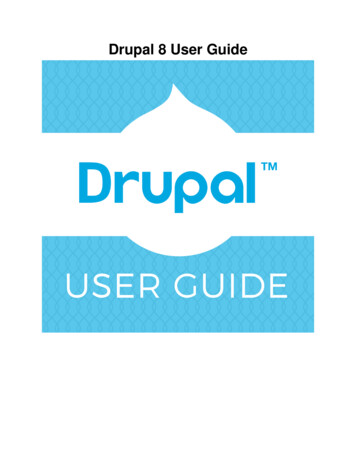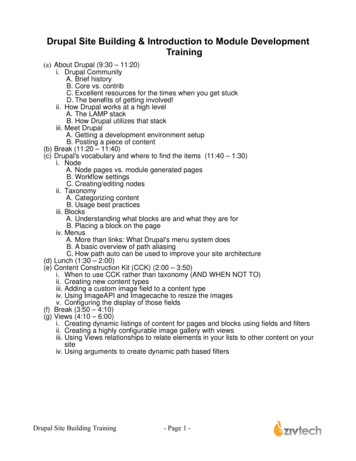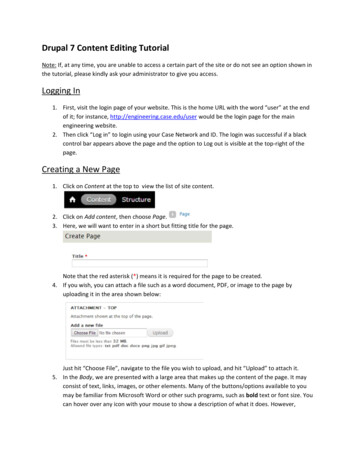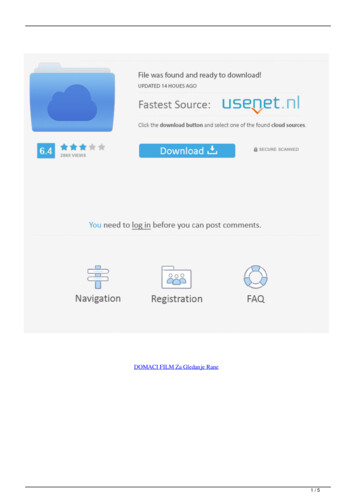
Transcription
drupal-7#drupal-7
Table of ContentsAbout1Chapter 1: Getting started with drupal-72Remarks2Examples2Installation or Setup2Installation Drupal 7 in steps2Step 1: Download and extract Drupal2Step 2: Create the database5Step 3: Create settings.php and the files directory6Step 4: Run the installation script9Chapter 2: Drupal Folder shotCredits1920
AboutYou can share this PDF with anyone you feel could benefit from it, downloaded the latest versionfrom: drupal-7It is an unofficial and free drupal-7 ebook created for educational purposes. All the content isextracted from Stack Overflow Documentation, which is written by many hardworking individuals atStack Overflow. It is neither affiliated with Stack Overflow nor official drupal-7.The content is released under Creative Commons BY-SA, and the list of contributors to eachchapter are provided in the credits section at the end of this book. Images may be copyright oftheir respective owners unless otherwise specified. All trademarks and registered trademarks arethe property of their respective company owners.Use the content presented in this book at your own risk; it is not guaranteed to be correct noraccurate, please send your feedback and corrections to info@zzzprojects.comhttps://riptutorial.com/1
Chapter 1: Getting started with drupal-7RemarksThis section provides an overview of what drupal-7 is, and why a developer might want to use it.It should also mention any large subjects within drupal-7, and link out to the related topics. Sincethe Documentation for drupal-7 is new, you may need to create initial versions of those relatedtopics.Drupal is written in PHP with a great deal of JavaScript (mostly using the JQuery library) for thefront-end experience, and it uses a database such as MariaDB/MySQL or PostgreSQL to storeboth content and configuration.ImplementationTo begin building any Drupal website, you first need to install Drupal. Many different combinationsof operating systems (Linux, Windows, Mac OS X), web servers (Apache, IIS, Nginx), anddatabases (MariaDB/MySQL, PostgreSQL, SQLite) support Drupal.ExamplesInstallation or SetupDetailed instructions on getting drupal-7 set up or installed.Installation Drupal 7 in stepsStep 1: Download and extract DrupalDrupal is available in two supported versions: the most recent and the previous. Currently that isDrupal 8 (released November 2015) and Drupal 7. The Recommended releases are the lateststable releases of either version. To learn more about versions, see the Drupal version informationpage.To install a Drupal site in a language other than English, see http://localize.drupal.org/translate.You can also add additional languages after the installation.Note: If you install Drupal 8, you can choose the installation language as the first option in theinterface of the installation script itself.You can download and extract Drupal in six different ways: using Drush using Drupal Console from the command linehttps://riptutorial.com/2
using FTP using Git using composerSo, follow one of the methods below for downloading, and then.Before continuing to the next page .The base URL for your Drupal installation is set in your web server's configuration file. You needto know this URL before proceeding to the next steps of the installation. If you are installing Drupalon your local machine, the base URL may be http://localhost. If you're installing Drupal to a webserver, your base URL may be a specific domain name, such as http://example.com.DrushDrush is a command line tool to maintain and administer Drupal sites. It offers the most convenientway of downloading Drupal by using a single command: pm-download (or its alias dl):drush dl drupalThis command will download the recommended version into the current folder. Check drushdl to see additional options such as how to download a specific version.helpDrupal ConsoleDrupal Console is the new command line interface (CLI) for Drupal. The Drupal Console is a toolto generate boilerplate code, interact and debug Drupal 8. It offers a convenient way ofdownloading Drupal by using a single command:site:new:# specifying to download version 8.0.2 into folder "mydrupalsite"drupal site:new mydrupalsite 8.0.2# select version from interactive modedrupal site:new mydrupalsiteThis command will download the specified version into the current folder. Check drupal-help or visit the documentation.site:new -From the command lineDownloadingLog into your server on using ssh and navigate to the directory from which you will be serving yourDrupal site. On many *nix computers the path from the server's root will be /var/www/html, so cd/var/www/html. On a shared server, or a server that hosts multiple domains, the path will bedifferent (try cd /www or cd /public html). If you are unsure of the directory, ask your hostingprovider for assistance.https://riptutorial.com/3
Download Drupal from the command line, for example using wget or curl. The commands are,respectively:wget r.gzorcurl -O r.gzNote: The curl command option is the upper case letter "O" and not the numeral that stands forzero.Replace r.gz with the link for the version youwant to install.The links to the recommended versions are available on Drupal Core project page, where you cancopy them from the Download column. All other versions are available on the Releases for Drupalcore page.Extracting filesType the following command and replace "x.x" with your downloaded version's number:tar -xvzf drupal-x.x.tar.gzThen remove the compressed version of the file by using the following command:rm drupal-x.x.tar.gzMoving to its intended locationNow you need to move the contents of the drupal-x.x directory one level "up" into the web server'sdocument root or your public HTML directory:mv drupal-x.x/* drupal-x.x/.htaccess ./For Drupal 7, also add:mv drupal-x.x/.gitignore ./Drupal 8 comes with several additional hidden files that all need to be moved as well.Alternative, you can extract the the tar archive directly into the correct directory by typing:tar --strip-components 1 -xvzf drupal-x.x.tar.gzThe files from the directory you downloaded and decompressed have now been moved up a levelinto your web directory, and you can delete the (now empty) drupal-x.x directory:https://riptutorial.com/4
rmdir drupal-x.xUsing FTPYou can download Drupal using your favorite FTP-tool.1. Download a Drupal tar.gz or zip file to your local computer fromhttps://www.drupal.org/project/drupal by clicking on the link for the version you want toinstall.2. When you download the file, your browser will ask you what to do with it. Choose "Extract"and extract it to your local computer. Or, save the file and extract it using your computer'ssoftware (7-zip for example) that deals with archive files. The exact steps to do this differ bysoftware, but you should end up with a folder/directory called something like "drupal-7.32" onyour local computer.3. Use FTP to transfer the entire contents of this folder, including hidden files like .htaccess, toyour hosting account's HTML document root. Details of how to do this depend on your FTPsoftware.Note: Drupal 8 includes about 10 times as many files as earlier versions (due to its newframework), that may take significantly longer to upload to a server by FTP than earlier versions. Afaster way to upload Drupal 8 as a single ZIP files, suitable for some hosts is described here.Using GitThe Drupal project page has great version control instructions, which starts with setting uprepository for the first time by cloning Drupal.When cloning Drupal 8.1.x or higher you will need to use composer to install the latestdependencies. From the root directory of the Drupal repository you cloned run composer install,this will download all the dependencies to the location expected by Drupal. See also this methodfor building sites with composer.If you do not have composer installed follow their documentation.Step 2: Create the databaseNote: Since 8.x, it is not necessary to create a database before installing Drupal. Now, if you entercredentials of a user capable of creating databases (for example the 'CREATE' privilege inMySQL/MariaDB or the 'CREATEDB' privilege in postgresql), the specified database name will becreated at the time of Drupal installation if it doesn't already exist. See the relevant change noticefor more information and screenshots. If you do have a user with these privileges, you can moveto the next step.Before running the installation script, you must create an empty database and database user (auser name assigned the rights to use the Drupal database).Drupal 7https://riptutorial.com/5
If you use capital letters in the database name, they will be converted to lower case. A "-" (hyphen)in the database name will be encoded as "@002d" in the database folder name. For example, thefolder name for database a-b-c will be a@002db@002dc. Other characters besides a.z, 0.9, and" " (underscore) are similarly encoded. [ref, ref]Drupal 8If you use capital letters in the database name, they will be converted to lower case. Allowedcharacters are a.z, 0.9, and " " (underscore).Step 3: Create settings.php and the files directoryDrupal Config File "settings.php" and "services.yml" OverviewIn order for Drupal to work, you have to configure where the database is, what the database iscalled, and the database credentials to access the database. This information is stored in thesettings.php file which is located in:sites/defaultThe settings.php file is common to Drupal 6, 7 and 8When you first extract Drupal, it doesn't come with a settings.php file, instead it comes withdefault.settings.php. When you first install Drupal 7, it will attempt to copy and renamedefault.settings.php - settings.php for you. There are some rare instances where you will need todo this manually which are covered in detail further down on this page.New to Drupal 8 in the sites/default folder, is a file named default.services.yml. Just likedefault.settings.php, default.services.yml has to be renamed in order to work. However, this file isdesigned for overriding the core services.yml file if you need to override it and 99% of sites outthere, won't ever need to override the core services.yml file. It is made available if you do need tooverride those settings though. In early development, this file was automatically copied andrenamed during install, however Stop creating services.yml by default supersedes the earlymethod. In other words, don't ever worry about default.services.yml / services.yml unlesssomething tells you otherwise.Finally, the purpose of having default.[config-file].php is so you can easily update Drupal, withoutoverwriting the entire configuration that runs your site. Yes, there was a time when thathappened.Automatic settings.php OverviewBy default, Drupal 7 and 8 will attempt to create and populate the settings.php file automaticallywhen you use install.php to setup the site. The script also changes the permission on the file tosecure it once it is finished and then creates a sites/default/files directory for housing all of yournon-core files. Unfortunately, some types of shared/local hosting are configured so PHP andApache run as the same user. This might result in the install script failing to execute the creationand population of the settings.php file, along with setting permissions and creating the fileshttps://riptutorial.com/6
directory. If you get errors referring to the Settings file during installation, you will have to manuallycreate the settings.php file and do a few more tasks before you can run install.php. Once it iscreated with write permissions, the installation script will automatically populate the properinformation for your site config. Afterwards, you will have to re-secure the settings.php file.At this point, jump to the next page step: Step 4: Run the installation script. If you run intoproblems with the installation due to the Settings, come back here and follow the Manual stepsoutlined below.Manual settings.php OverviewDrupal 6, 7 and 8 come with a sample settings.php configuration file located at:sites/default/default.settings.phpBefore you run the installation script (install.php), you need to copy default.settings.php file as anew file called settings.php and change its permissions to be writeable. After the installation, youwill need to restrict the permissions again.Manual settings.php Detailed Instructions Step 1 - Navigation & CreationNavigate to sites/default of your root Drupal install.Copy the default.settings.php file and save the new file as settings.php in the same directory(see note below about renaming). If you have shell access (command line) run the followingcommand from the directory that contains your Drupal installation files:cp sites/default/default.settings.php sites/default/settings.phpNote: Do not simply rename the file. The Drupal installer needs both files.If you only have FTP access, you will have to download the file to your computer, rename it,then upload it. Some hosting providers have a file manager on the dashboard where the filecan be copied and renamed. Step 2 - Check the Permissions Are WriteableBy default, the sites/default directory and the settings.php file should be writeable. Youcan check that the permissions of sites/default and settings.php are writeable by issuing thefollowing commands:ls -l sites/Permission on sites/default should be 755 [drwxr-xr-x]:ls -l sites/default/settings.phpPermission on settings.php should be 644 [-rw-r--r--]:https://riptutorial.com/7
If they are anything but writeable, you can issue the following commands:chmod 644 sites/default/settings.phpNote: If you are in the same group as the web user, then changing the permissions to 664will be sufficient.Several FT
Chapter 1: Getting started with drupal-7 2 Remarks 2 Examples 2 Installation or Setup 2 Installation Drupal 7 in steps 2 Step 1: Download and extract Drupal 2 Step 2: Create the database 5 Step 3: Create settings.php and the files directory 6 Step 4: Run the installation script 9 Chapter 2: Drupal Folder Structure 18 Introduction 18 Remarks 18 Examples 18 Screenshot 19 Credits 20. About You .

